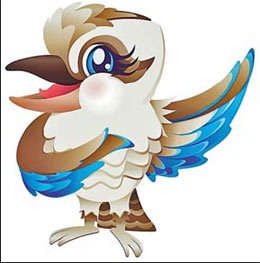Xiao Xiao or Le Le? Which "happy" name is best-suited to the cheeky and bold kookaburra? Or is there a more creative name waiting in the wings for Australia's cherished bird and former Olympic mascot?
The Australian Pavilion at the upcoming Shanghai Expo is inviting all residents of China to propose an appropriate name for its official 2010 Expo mascot. The winner will receive a prize package including the opportunity to see the kookaburra first-hand in its native home.
"Clever, confident, and resourceful with a cheeky sense of humor, the kookaburra reflects well the personality of the Australian people," said Peter Tesch, commissioner-general for the Australian Pavilion.

"We wanted to showcase a uniquely Australian animal that was less well-known to Chinese audiences, thereby demonstrating the depth and diversity of Australia - its people, its achievements and its culture," he added.
Given the fact that the bird will be living in Shanghai for the next 18 months, it is only fitting that he be given a Chinese name, Tesch said.
In the eyes of Beijing college student Yang Shuo, the bird should be named Xiao Xiao, which means "laugh" in Chinese. "The bird's song sounds like human laughter. This name also has an auspicious meaning as it suggests a joyful expo experience," the 23-year-old said.
Tang Hanshan, who works for a foreign company in Shanghai, said Le Le, which also translates loosely as "happy," is more suitable because it sounds more manly and the mascot is supposed to be male.
Local cultural experts said any potential Chinese name should focus on the joyful spirit of the 2010 Expo and be easy to remember.
Entrants are encouraged to come up with a name and explain why they have selected it in 25 words or less. The winning entry will receive a substantial prize, including a week-long trip to Australia for three people. ANZ Banking Group will also provide the winner with a 2,000-Australian-dollar bank account.
The competition will run for six weeks until June 19. Entrants can find application forms and full terms and conditions on the country's newly launched website at www.australianpavilion.com. The winner will be announced next month.
More about the kookaburra
There are two types of kookaburra in Australia: the laughing kookaburra and blue-winged kookaburra. They range between 40 and 45 cm in length and weigh approximately 340 grams, the weight of five or six boiled eggs.
Like its relative the Pied Kingfisher that lives in China, the kookaburra is a gregarious bird. It is also sociable, communal and can be tamed. Its beak, attractive feather markings and spiky tufts of hair on the back of its head are also reminiscent of the Chinese bird.
According to Aboriginal folklore, spirits from the sky asked the kookaburra to laugh his loudest just before sunrise to awaken everyone from their sleep so they could appreciate how beautiful the earth looks at first light.
Kookaburras have adapted to a range of environments and are found in woodlands, open plains and coastal areas throughout Australia. They are also found in sparsely populated urban areas.

